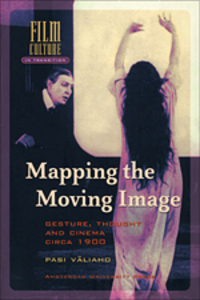Mapping the Moving Image: Gesture, Thought and Cinema circa 1900
Valiaho, Pasi. 2010. Mapping the Moving Image: Gesture, Thought and Cinema circa 1900. Amsterdam: Amsterdam University Press. ISBN 978-9-089-64140-3 [Book]
![[img]](https://research.gold.ac.uk/3546/1.hassmallThumbnailVersion/mapping.jpeg)
|
Image
mapping.jpeg - Cover Image Download (40kB) | Preview |
Abstract or Description
In 'Mapping the Moving Image', Pasi Väliaho shows how cinema came to change the way we act, think, and most of all feel the relationship between our bodies and the world in which we live. By locating the moving image at the turn of the twentieth century amongst the ways of seeing and saying so manifest in the arts, science and philosophy, the book redefines the cinema as a signal feature in the anthropology of the modern subject. 'Mapping the Moving Image' understands rhythm as the pervasive force that cinema harnesses to generate affectivity, animate behavior, and to determine the logics of sense. It provides a clear picture of how the forms of early film, when mobilizing bodily gestures and demanding intimate, affective engagement from the viewer, emerged in relation to bio-political investments in the body. In close-readings of the key thinkers of modernity (Henri Bergson, Sigmund Freud, Friedrich Nietzsche, in particular), the book demonstrates how cinema fed into their thinking of time, memory and the unconscious, and subsequently our own.
|
Item Type: |
Book |
| Departments, Centres and Research Units: |
Media, Communications and Cultural Studies |
| Date: |
February 2010 |
| Item ID: |
3546 |
| Date Deposited: |
16 Sep 2010 13:25 |
| Last Modified: |
19 Feb 2015 02:34 |
|
URI: |
View statistics for this item...
 |
Edit Record (login required) |

 Tools
Tools Tools
Tools
